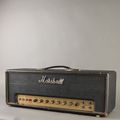This Plexi-era Marshall 50w Tremolo presents itself in an unassuming way, but has an impressive set of features lurking under the hood!
Like the JTM50, this 50w Tremolo has the full JTM45 preamp circuitry, along with EL34 power tubes and a GZ34 rectifier. While there was factory drilled holes for a side mounted filter cap, it's likely the rectifier tube socket was added later, due to the presence of new wires coming from the power transformer taps.
Compared to the JMP 1987 circuit from 1968, this amp still has a shared cathode preamp, a 56k slope resistor on the tone stack, and larger 0.1uf caps in the phase inverter. The result is less aggressive gain than the '68 "Lead" circuit, but it still delivers the great power and midrange response of the EL34 tubes, compared to the softer KT66 sound of the JTM45. Factory-built JTM50 Marshalls might have slightly different transformer combinations (PT: 1202-133, OT: 784-139), but many say the difference is negligible—most of the sound comes from the combo of JTM45 circuit, EL34 tubes, and GZ34 rectifier.
You may have noticed the tremolo feature hasn't been discussed—simply because most people aren't interested in that aspect. As with many tremolo-equipped Marshalls, the tremolo in this amp has been disabled to optimize the authentic 'Plexi sound. Internally, the electrolytic caps, power tube, and rectifier sockets have been replaced. The original pilot light and fuse holders have also been swapped.
The majority of the pots in this amp date to July 1967, though it was likely assembled in late '67. This amp was built as a U.S. import model, so it has a hard-wired power cord, which has been replaced with a modern one. 1k/5W screen grid resistors were added, which is essential for tube longevity with modern EL34s. Additionally, someone installed 1-ohm resistors on the cathodes for easier bias measurement. The 1W carbon comp resistors used in the circuit are likely not stock but are vintage parts. The 470-ohm resistor in the phase inverter cathode has also been swapped.
The back panel is missing, and the logo is a modern replacement - please check the pictures for further details. As you'll notice, the circuit is mostly stock, with only utility parts like the power tube sockets and fuse holders replaced. Ultimately, this particular combination of features results in an incredible-sounding amp!









